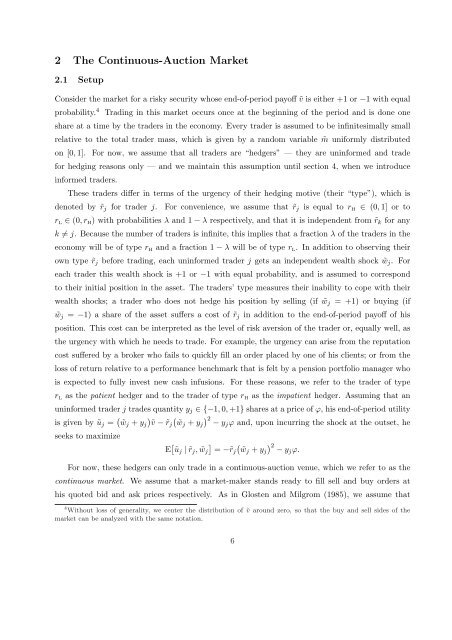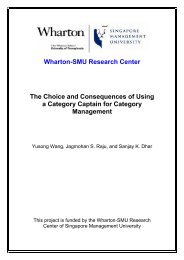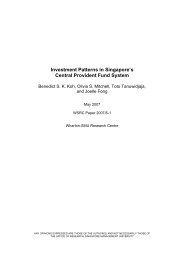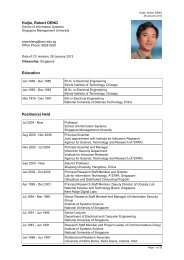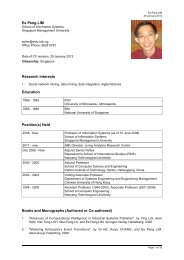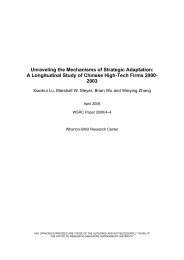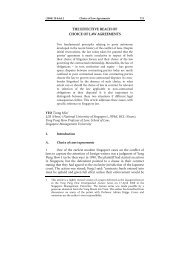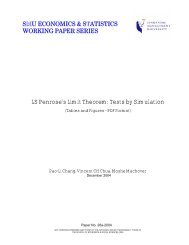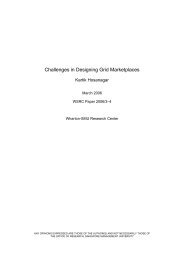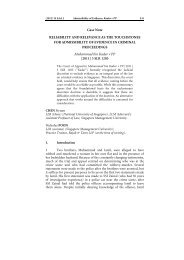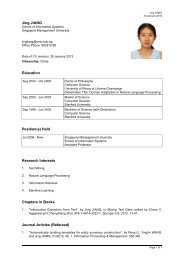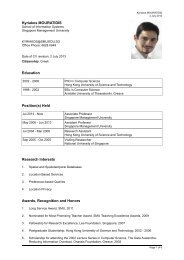The Benefits of Volume-Conditional Order-Crossing - Singapore ...
The Benefits of Volume-Conditional Order-Crossing - Singapore ...
The Benefits of Volume-Conditional Order-Crossing - Singapore ...
You also want an ePaper? Increase the reach of your titles
YUMPU automatically turns print PDFs into web optimized ePapers that Google loves.
2 <strong>The</strong> Continuous-Auction Market<br />
2.1 Setup<br />
Consider the market for a risky security whose end-<strong>of</strong>-period pay<strong>of</strong>f ˜v is either +1 or −1 with equal<br />
probability. 4 Trading in this market occurs once at the beginning <strong>of</strong> the period and is done one<br />
share at a time by the traders in the economy. Every trader is assumed to be infinitesimally small<br />
relative to the total trader mass, which is given by a random variable ˜m uniformly distributed<br />
on [0, 1]. For now, we assume that all traders are “hedgers” — they are uninformed and trade<br />
for hedging reasons only — and we maintain this assumption until section 4, when we introduce<br />
informed traders.<br />
<strong>The</strong>se traders differ in terms <strong>of</strong> the urgency <strong>of</strong> their hedging motive (their “type”), which is<br />
denoted by ˜rj for trader j. For convenience, we assume that ˜rj is equal to r H ∈ (0, 1] or to<br />
r L ∈ (0, r H) with probabilities λ and 1 − λ respectively, and that it is independent from ˜rk for any<br />
k = j. Because the number <strong>of</strong> traders is infinite, this implies that a fraction λ <strong>of</strong> the traders in the<br />
economy will be <strong>of</strong> type r H and a fraction 1 − λ will be <strong>of</strong> type r L. In addition to observing their<br />
own type ˜rj before trading, each uninformed trader j gets an independent wealth shock ˜wj. For<br />
each trader this wealth shock is +1 or −1 with equal probability, and is assumed to correspond<br />
to their initial position in the asset. <strong>The</strong> traders’ type measures their inability to cope with their<br />
wealth shocks; a trader who does not hedge his position by selling (if ˜wj = +1) or buying (if<br />
˜wj = −1) a share <strong>of</strong> the asset suffers a cost <strong>of</strong> ˜rj in addition to the end-<strong>of</strong>-period pay<strong>of</strong>f <strong>of</strong> his<br />
position. This cost can be interpreted as the level <strong>of</strong> risk aversion <strong>of</strong> the trader or, equally well, as<br />
the urgency with which he needs to trade. For example, the urgency can arise from the reputation<br />
cost suffered by a broker who fails to quickly fill an order placed by one <strong>of</strong> his clients; or from the<br />
loss <strong>of</strong> return relative to a performance benchmark that is felt by a pension portfolio manager who<br />
is expected to fully invest new cash infusions. For these reasons, we refer to the trader <strong>of</strong> type<br />
r L as the patient hedger and to the trader <strong>of</strong> type r H as the impatient hedger. Assuming that an<br />
uninformed trader j trades quantity yj ∈ {−1, 0, +1} shares at a price <strong>of</strong> ϕ, his end-<strong>of</strong>-period utility<br />
is given by ũj = 2 ˜wj + yj ˜v − ˜rj ˜wj + yj − yjϕ and, upon incurring the shock at the outset, he<br />
seeks to maximize<br />
E 2 ũj | ˜rj, ˜wj = −˜rj ˜wj + yj − yjϕ.<br />
For now, these hedgers can only trade in a continuous-auction venue, which we refer to as the<br />
continuous market. We assume that a market-maker stands ready to fill sell and buy orders at<br />
his quoted bid and ask prices respectively. As in Glosten and Milgrom (1985), we assume that<br />
4 Without loss <strong>of</strong> generality, we center the distribution <strong>of</strong> ˜v around zero, so that the buy and sell sides <strong>of</strong> the<br />
market can be analyzed with the same notation.<br />
6


